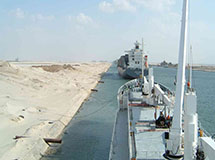 |
 |
|
| eNews • December 2013 | ||
| Promoting a Cost-Effective, Reliable and Competitive Transportation System |
||

The Suez Canal is steadily luring Asia-to-east coast of North America traffic from the Panama Canal thanks to the economies of scale it offers ocean carriers, and is set to further increase its market share because of the fresh delay in enlarging the locks of the Central American waterway, according to Drewry Maritime Research.
Furthermore, ocean carriers “will not be too troubled by the further delay to the Panama Canal’s new locks, as they have already gained some, if not all, of the economies of scale that the new locks will offer,” the London-based consultancy said.
The Suez Canal Authority has already persuaded several ocean carriers on the arterial Asia-to-east coast of North America route to switch from the Panama Canal this year. The Egyptian waterway has increased its share of capacity on the route from around one-third between October 2010 and October 2012 to 42 percent in October 2013, with the Panama Canal’s share falling from two-thirds to 58 percent. The further postponement of the opening of the enlarged Panama Canal from mid-2015 to the end of 2015 will give the Suez Canal Authority more time attract to further carriers, Drewry said.
The increased market share of the Suez Canal has resulted from the average size of its ships growing from 6,911 TEUs over the past year to 7,756 TEUs, as well as the transfer of Maersk Line’s TP7 schedule from the Panama Canal. Ships using the Panama Canal have remained at below 5,000 TEUs.
It’s “just a question of time” before all services passing through the Suez Canal will deploy vessels of more than 8,000 TEUs, Drewry predicts.
The Panama Canal Authority will be further concerned about the continuing reluctance of North American importers to switch traffic away from the West Coast to the East Coast, as the only significant change so far has been the transfer of existing East Coast business from the Central American waterway to the Suez Canal. The proportion of ship capacity sailing toward the east coast of North America has remained at just over 25 percent of the total operating from Asia to North America, matching cargo flows that reached 25.3 percent in 2011, 25.2 percent in 2012 and 26.3 percent in the first eight months of 2013. This is mainly because eastbound transit times are much faster via the West Coast; China to Los Angeles can take between 10 and 15 days, while U.S. East Coast ports are often only reached after 30 days, on top of which there is a freight rate differential of just under $1,500 for a 40-foot container.
Further cause of concern for the Panama Canal is that cargo growth to the east coast of North America is stalling at a time when ships transiting the Suez Canal have been taking on more traffic at Asian ports. Until recently, Suez Canal-bound ships have been restricted to Southeast Asian ports as a result of the shorter distance compared with the Panama Canal, but now they are regularly loading at northeast Asian ports.
However, Drewry says the damage caused by the overdue opening of the Panama Canal’s new locks is not irreparable.
“Everything currently being lost through Suez could easily be switched back to the Panama Canal depending on the level of its new tariffs,” Drewry explained.
The Suez Canal Authority currently charges about $1 million for a combined northbound and southbound transit by ships of between 8,000 TEUs and 9,000 TEUs.
Source: Journal of Commerce
Soy Transportation Coalition |
|
